A Detailed Comparison of Agile Project Management and PMBOK Models
VerifiedAdded on 2020/05/04
|14
|2952
|70
Report
AI Summary
This report provides a comprehensive comparison between Agile project management and the PMBOK (Project Management Body of Knowledge) model for software development. It begins with an executive summary and table of contents, setting the stage for a detailed discussion of both methodologies. The report explores various Agile models, including Extreme Programming (XP), Scrum, and Feature-Driven Development (FDD), outlining their core principles and practices. It then contrasts these Agile approaches with the PMBOK framework, examining key areas such as project scope, time, cost, quality, human resource management, communication, and risk management. The report highlights the applicability of each model, noting that Agile is well-suited for projects with evolving requirements and smaller teams, while PMBOK offers a standardized approach beneficial for larger organizations. The report concludes by summarizing the key findings and emphasizing the strengths of each model in different project contexts. The report is a comparative analysis of two project management approaches.
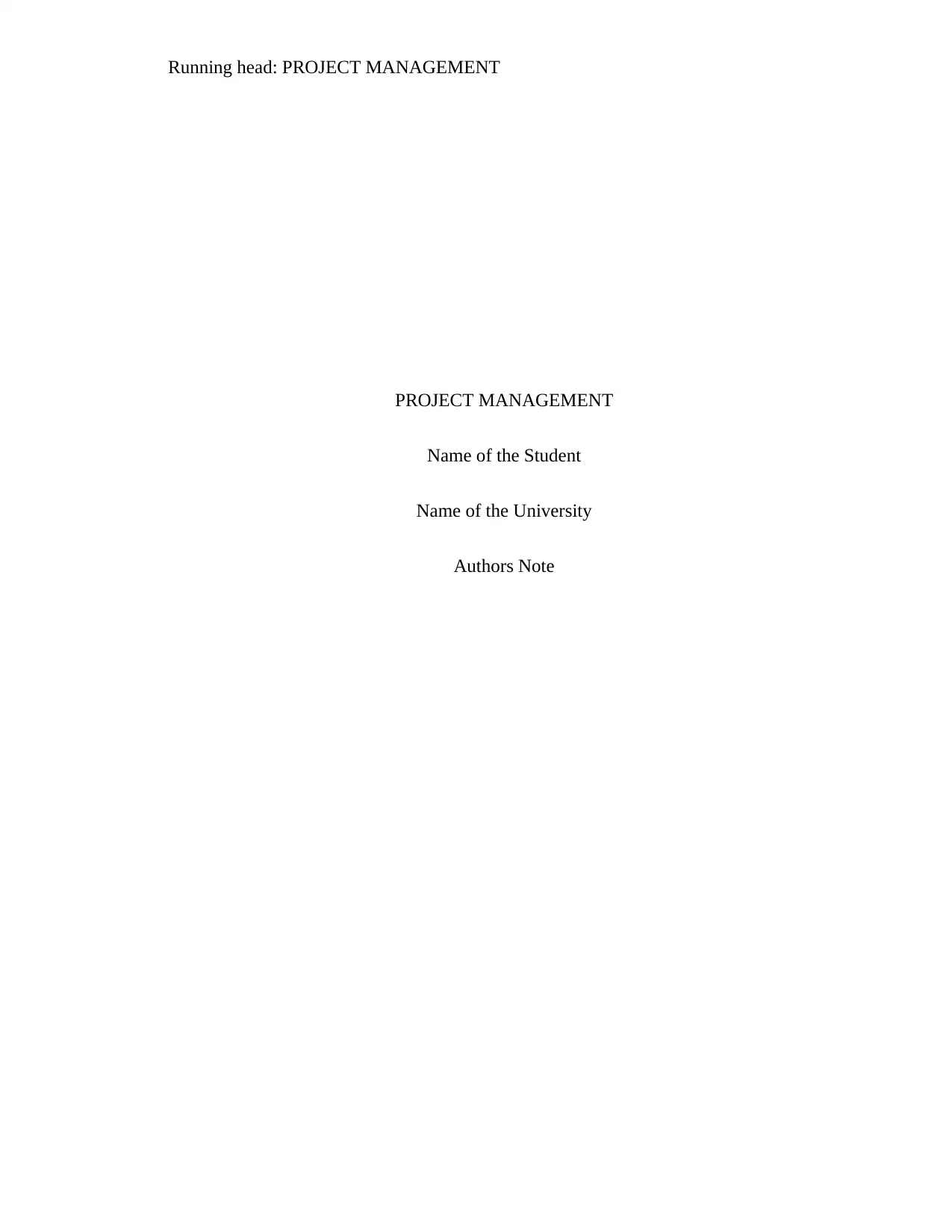
Running head: PROJECT MANAGEMENT
PROJECT MANAGEMENT
Name of the Student
Name of the University
Authors Note
PROJECT MANAGEMENT
Name of the Student
Name of the University
Authors Note
Paraphrase This Document
Need a fresh take? Get an instant paraphrase of this document with our AI Paraphraser
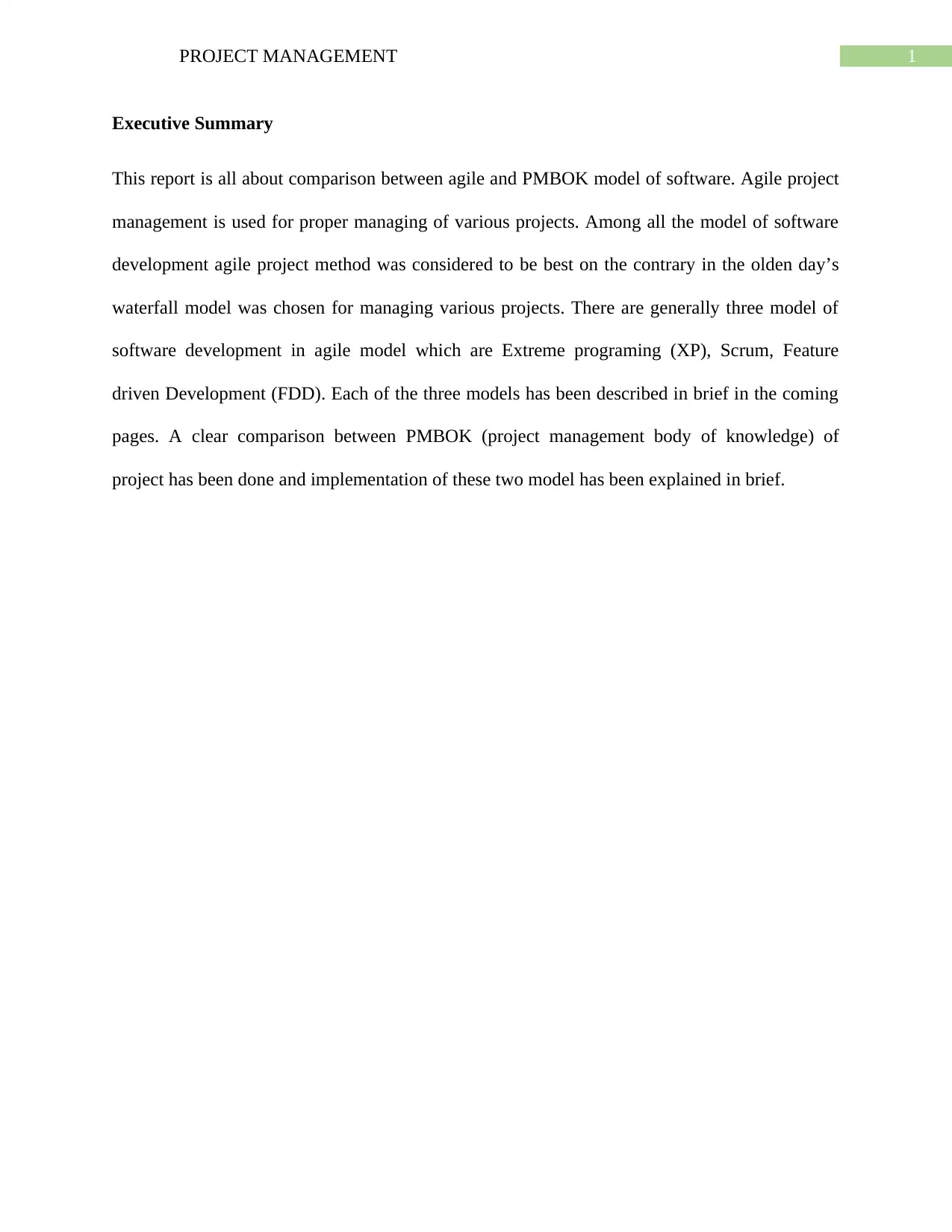
1PROJECT MANAGEMENT
Executive Summary
This report is all about comparison between agile and PMBOK model of software. Agile project
management is used for proper managing of various projects. Among all the model of software
development agile project method was considered to be best on the contrary in the olden day’s
waterfall model was chosen for managing various projects. There are generally three model of
software development in agile model which are Extreme programing (XP), Scrum, Feature
driven Development (FDD). Each of the three models has been described in brief in the coming
pages. A clear comparison between PMBOK (project management body of knowledge) of
project has been done and implementation of these two model has been explained in brief.
Executive Summary
This report is all about comparison between agile and PMBOK model of software. Agile project
management is used for proper managing of various projects. Among all the model of software
development agile project method was considered to be best on the contrary in the olden day’s
waterfall model was chosen for managing various projects. There are generally three model of
software development in agile model which are Extreme programing (XP), Scrum, Feature
driven Development (FDD). Each of the three models has been described in brief in the coming
pages. A clear comparison between PMBOK (project management body of knowledge) of
project has been done and implementation of these two model has been explained in brief.
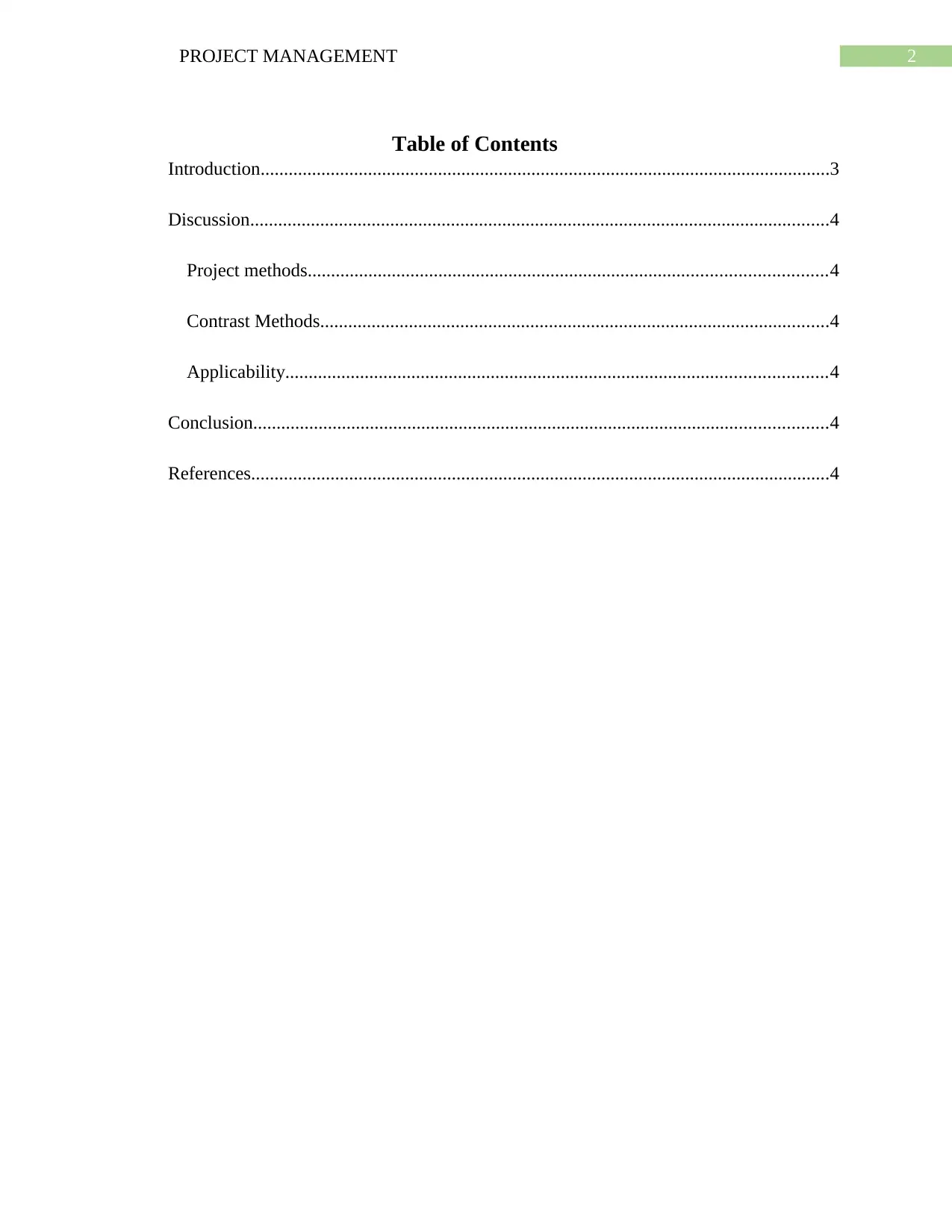
2PROJECT MANAGEMENT
Table of Contents
Introduction..........................................................................................................................3
Discussion............................................................................................................................4
Project methods...............................................................................................................4
Contrast Methods.............................................................................................................4
Applicability....................................................................................................................4
Conclusion...........................................................................................................................4
References............................................................................................................................4
Table of Contents
Introduction..........................................................................................................................3
Discussion............................................................................................................................4
Project methods...............................................................................................................4
Contrast Methods.............................................................................................................4
Applicability....................................................................................................................4
Conclusion...........................................................................................................................4
References............................................................................................................................4
⊘ This is a preview!⊘
Do you want full access?
Subscribe today to unlock all pages.

Trusted by 1+ million students worldwide
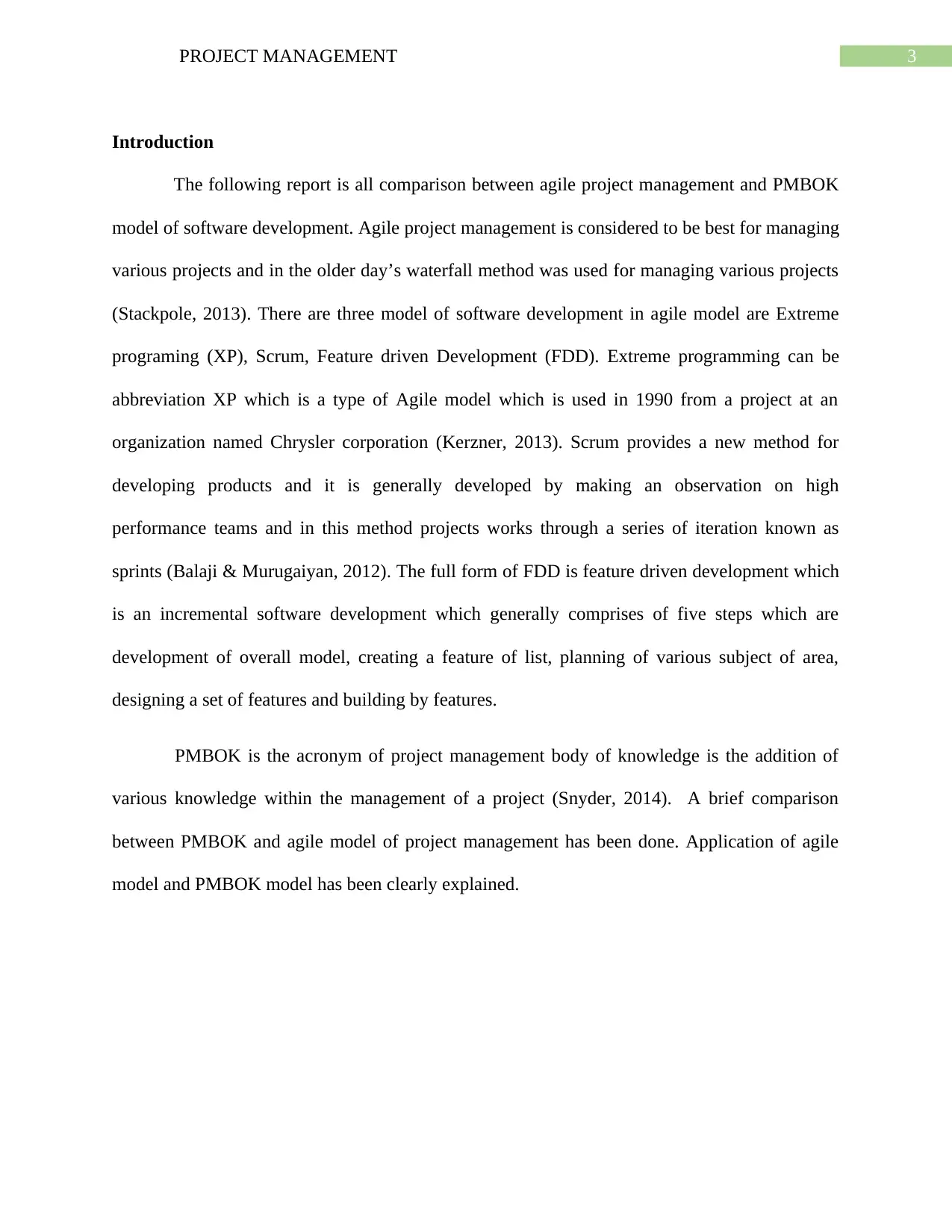
3PROJECT MANAGEMENT
Introduction
The following report is all comparison between agile project management and PMBOK
model of software development. Agile project management is considered to be best for managing
various projects and in the older day’s waterfall method was used for managing various projects
(Stackpole, 2013). There are three model of software development in agile model are Extreme
programing (XP), Scrum, Feature driven Development (FDD). Extreme programming can be
abbreviation XP which is a type of Agile model which is used in 1990 from a project at an
organization named Chrysler corporation (Kerzner, 2013). Scrum provides a new method for
developing products and it is generally developed by making an observation on high
performance teams and in this method projects works through a series of iteration known as
sprints (Balaji & Murugaiyan, 2012). The full form of FDD is feature driven development which
is an incremental software development which generally comprises of five steps which are
development of overall model, creating a feature of list, planning of various subject of area,
designing a set of features and building by features.
PMBOK is the acronym of project management body of knowledge is the addition of
various knowledge within the management of a project (Snyder, 2014). A brief comparison
between PMBOK and agile model of project management has been done. Application of agile
model and PMBOK model has been clearly explained.
Introduction
The following report is all comparison between agile project management and PMBOK
model of software development. Agile project management is considered to be best for managing
various projects and in the older day’s waterfall method was used for managing various projects
(Stackpole, 2013). There are three model of software development in agile model are Extreme
programing (XP), Scrum, Feature driven Development (FDD). Extreme programming can be
abbreviation XP which is a type of Agile model which is used in 1990 from a project at an
organization named Chrysler corporation (Kerzner, 2013). Scrum provides a new method for
developing products and it is generally developed by making an observation on high
performance teams and in this method projects works through a series of iteration known as
sprints (Balaji & Murugaiyan, 2012). The full form of FDD is feature driven development which
is an incremental software development which generally comprises of five steps which are
development of overall model, creating a feature of list, planning of various subject of area,
designing a set of features and building by features.
PMBOK is the acronym of project management body of knowledge is the addition of
various knowledge within the management of a project (Snyder, 2014). A brief comparison
between PMBOK and agile model of project management has been done. Application of agile
model and PMBOK model has been clearly explained.
Paraphrase This Document
Need a fresh take? Get an instant paraphrase of this document with our AI Paraphraser
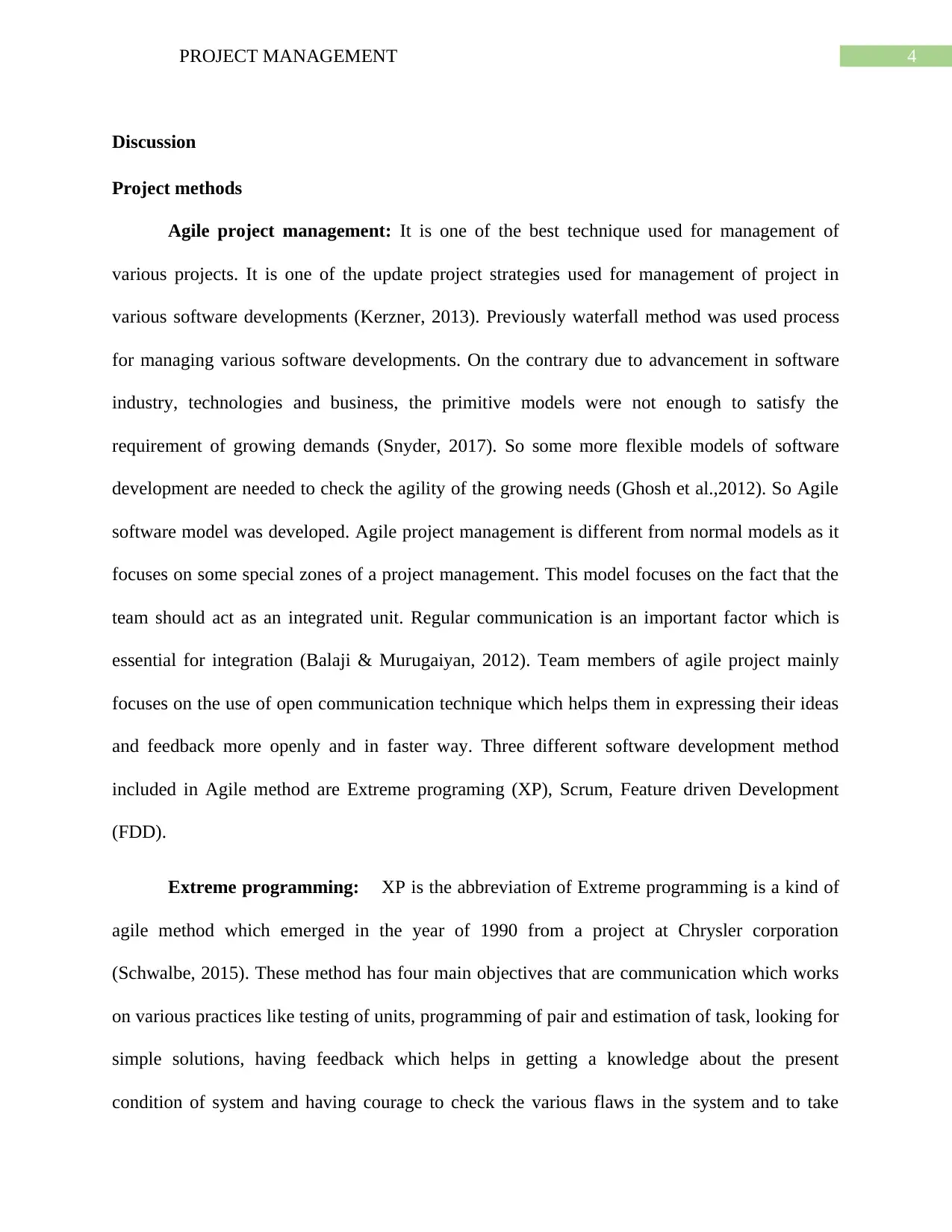
4PROJECT MANAGEMENT
Discussion
Project methods
Agile project management: It is one of the best technique used for management of
various projects. It is one of the update project strategies used for management of project in
various software developments (Kerzner, 2013). Previously waterfall method was used process
for managing various software developments. On the contrary due to advancement in software
industry, technologies and business, the primitive models were not enough to satisfy the
requirement of growing demands (Snyder, 2017). So some more flexible models of software
development are needed to check the agility of the growing needs (Ghosh et al.,2012). So Agile
software model was developed. Agile project management is different from normal models as it
focuses on some special zones of a project management. This model focuses on the fact that the
team should act as an integrated unit. Regular communication is an important factor which is
essential for integration (Balaji & Murugaiyan, 2012). Team members of agile project mainly
focuses on the use of open communication technique which helps them in expressing their ideas
and feedback more openly and in faster way. Three different software development method
included in Agile method are Extreme programing (XP), Scrum, Feature driven Development
(FDD).
Extreme programming: XP is the abbreviation of Extreme programming is a kind of
agile method which emerged in the year of 1990 from a project at Chrysler corporation
(Schwalbe, 2015). These method has four main objectives that are communication which works
on various practices like testing of units, programming of pair and estimation of task, looking for
simple solutions, having feedback which helps in getting a knowledge about the present
condition of system and having courage to check the various flaws in the system and to take
Discussion
Project methods
Agile project management: It is one of the best technique used for management of
various projects. It is one of the update project strategies used for management of project in
various software developments (Kerzner, 2013). Previously waterfall method was used process
for managing various software developments. On the contrary due to advancement in software
industry, technologies and business, the primitive models were not enough to satisfy the
requirement of growing demands (Snyder, 2017). So some more flexible models of software
development are needed to check the agility of the growing needs (Ghosh et al.,2012). So Agile
software model was developed. Agile project management is different from normal models as it
focuses on some special zones of a project management. This model focuses on the fact that the
team should act as an integrated unit. Regular communication is an important factor which is
essential for integration (Balaji & Murugaiyan, 2012). Team members of agile project mainly
focuses on the use of open communication technique which helps them in expressing their ideas
and feedback more openly and in faster way. Three different software development method
included in Agile method are Extreme programing (XP), Scrum, Feature driven Development
(FDD).
Extreme programming: XP is the abbreviation of Extreme programming is a kind of
agile method which emerged in the year of 1990 from a project at Chrysler corporation
(Schwalbe, 2015). These method has four main objectives that are communication which works
on various practices like testing of units, programming of pair and estimation of task, looking for
simple solutions, having feedback which helps in getting a knowledge about the present
condition of system and having courage to check the various flaws in the system and to take
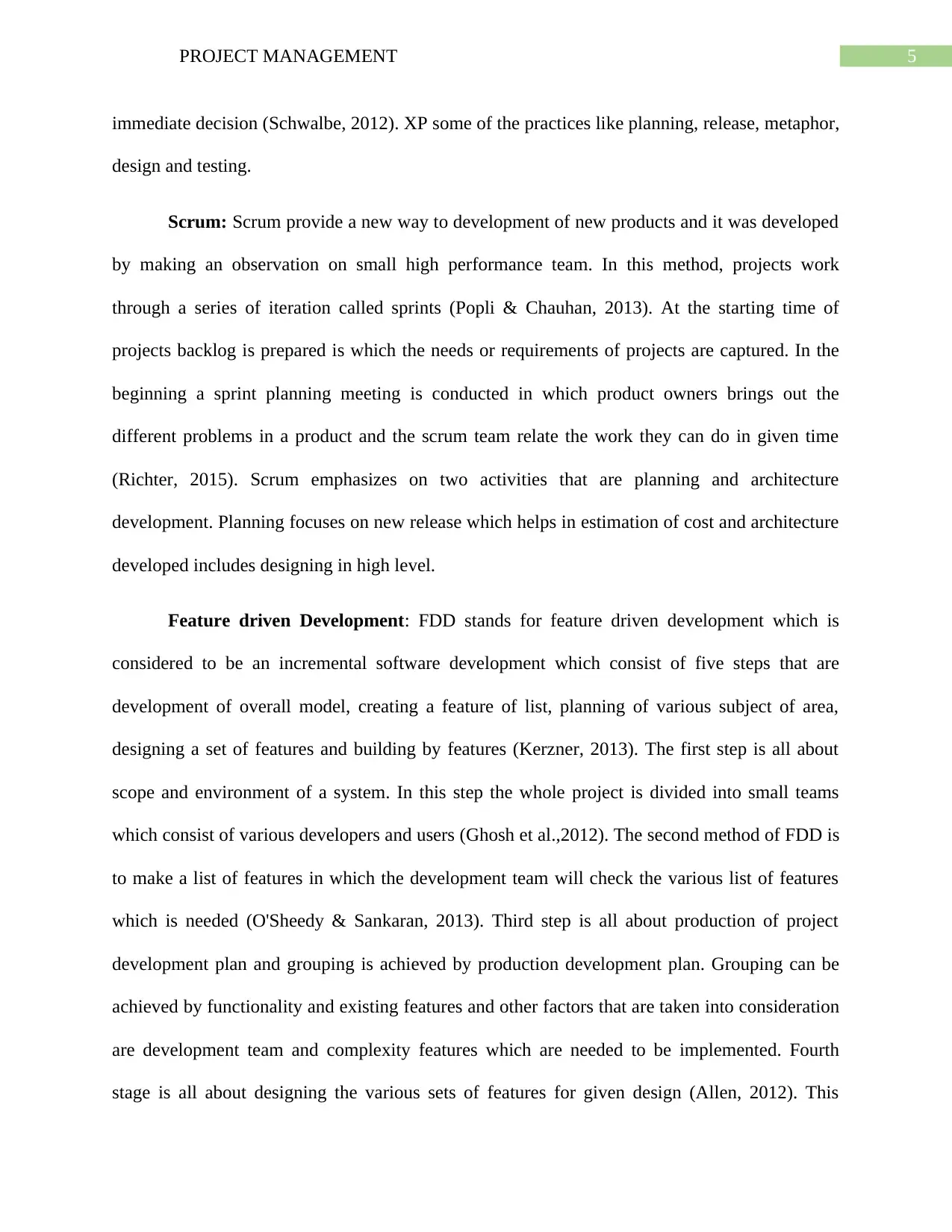
5PROJECT MANAGEMENT
immediate decision (Schwalbe, 2012). XP some of the practices like planning, release, metaphor,
design and testing.
Scrum: Scrum provide a new way to development of new products and it was developed
by making an observation on small high performance team. In this method, projects work
through a series of iteration called sprints (Popli & Chauhan, 2013). At the starting time of
projects backlog is prepared is which the needs or requirements of projects are captured. In the
beginning a sprint planning meeting is conducted in which product owners brings out the
different problems in a product and the scrum team relate the work they can do in given time
(Richter, 2015). Scrum emphasizes on two activities that are planning and architecture
development. Planning focuses on new release which helps in estimation of cost and architecture
developed includes designing in high level.
Feature driven Development: FDD stands for feature driven development which is
considered to be an incremental software development which consist of five steps that are
development of overall model, creating a feature of list, planning of various subject of area,
designing a set of features and building by features (Kerzner, 2013). The first step is all about
scope and environment of a system. In this step the whole project is divided into small teams
which consist of various developers and users (Ghosh et al.,2012). The second method of FDD is
to make a list of features in which the development team will check the various list of features
which is needed (O'Sheedy & Sankaran, 2013). Third step is all about production of project
development plan and grouping is achieved by production development plan. Grouping can be
achieved by functionality and existing features and other factors that are taken into consideration
are development team and complexity features which are needed to be implemented. Fourth
stage is all about designing the various sets of features for given design (Allen, 2012). This
immediate decision (Schwalbe, 2012). XP some of the practices like planning, release, metaphor,
design and testing.
Scrum: Scrum provide a new way to development of new products and it was developed
by making an observation on small high performance team. In this method, projects work
through a series of iteration called sprints (Popli & Chauhan, 2013). At the starting time of
projects backlog is prepared is which the needs or requirements of projects are captured. In the
beginning a sprint planning meeting is conducted in which product owners brings out the
different problems in a product and the scrum team relate the work they can do in given time
(Richter, 2015). Scrum emphasizes on two activities that are planning and architecture
development. Planning focuses on new release which helps in estimation of cost and architecture
developed includes designing in high level.
Feature driven Development: FDD stands for feature driven development which is
considered to be an incremental software development which consist of five steps that are
development of overall model, creating a feature of list, planning of various subject of area,
designing a set of features and building by features (Kerzner, 2013). The first step is all about
scope and environment of a system. In this step the whole project is divided into small teams
which consist of various developers and users (Ghosh et al.,2012). The second method of FDD is
to make a list of features in which the development team will check the various list of features
which is needed (O'Sheedy & Sankaran, 2013). Third step is all about production of project
development plan and grouping is achieved by production development plan. Grouping can be
achieved by functionality and existing features and other factors that are taken into consideration
are development team and complexity features which are needed to be implemented. Fourth
stage is all about designing the various sets of features for given design (Allen, 2012). This
⊘ This is a preview!⊘
Do you want full access?
Subscribe today to unlock all pages.

Trusted by 1+ million students worldwide
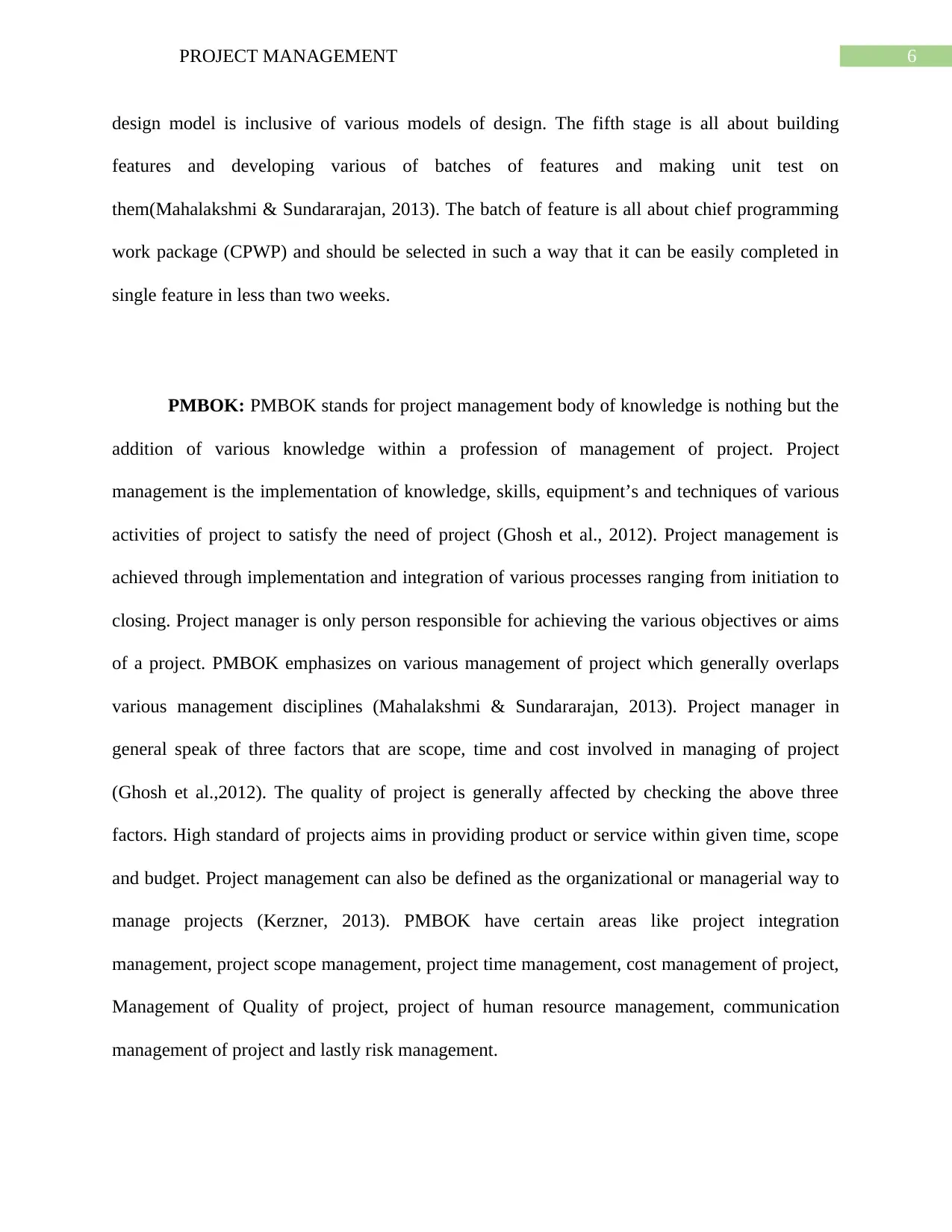
6PROJECT MANAGEMENT
design model is inclusive of various models of design. The fifth stage is all about building
features and developing various of batches of features and making unit test on
them(Mahalakshmi & Sundararajan, 2013). The batch of feature is all about chief programming
work package (CPWP) and should be selected in such a way that it can be easily completed in
single feature in less than two weeks.
PMBOK: PMBOK stands for project management body of knowledge is nothing but the
addition of various knowledge within a profession of management of project. Project
management is the implementation of knowledge, skills, equipment’s and techniques of various
activities of project to satisfy the need of project (Ghosh et al., 2012). Project management is
achieved through implementation and integration of various processes ranging from initiation to
closing. Project manager is only person responsible for achieving the various objectives or aims
of a project. PMBOK emphasizes on various management of project which generally overlaps
various management disciplines (Mahalakshmi & Sundararajan, 2013). Project manager in
general speak of three factors that are scope, time and cost involved in managing of project
(Ghosh et al.,2012). The quality of project is generally affected by checking the above three
factors. High standard of projects aims in providing product or service within given time, scope
and budget. Project management can also be defined as the organizational or managerial way to
manage projects (Kerzner, 2013). PMBOK have certain areas like project integration
management, project scope management, project time management, cost management of project,
Management of Quality of project, project of human resource management, communication
management of project and lastly risk management.
design model is inclusive of various models of design. The fifth stage is all about building
features and developing various of batches of features and making unit test on
them(Mahalakshmi & Sundararajan, 2013). The batch of feature is all about chief programming
work package (CPWP) and should be selected in such a way that it can be easily completed in
single feature in less than two weeks.
PMBOK: PMBOK stands for project management body of knowledge is nothing but the
addition of various knowledge within a profession of management of project. Project
management is the implementation of knowledge, skills, equipment’s and techniques of various
activities of project to satisfy the need of project (Ghosh et al., 2012). Project management is
achieved through implementation and integration of various processes ranging from initiation to
closing. Project manager is only person responsible for achieving the various objectives or aims
of a project. PMBOK emphasizes on various management of project which generally overlaps
various management disciplines (Mahalakshmi & Sundararajan, 2013). Project manager in
general speak of three factors that are scope, time and cost involved in managing of project
(Ghosh et al.,2012). The quality of project is generally affected by checking the above three
factors. High standard of projects aims in providing product or service within given time, scope
and budget. Project management can also be defined as the organizational or managerial way to
manage projects (Kerzner, 2013). PMBOK have certain areas like project integration
management, project scope management, project time management, cost management of project,
Management of Quality of project, project of human resource management, communication
management of project and lastly risk management.
Paraphrase This Document
Need a fresh take? Get an instant paraphrase of this document with our AI Paraphraser
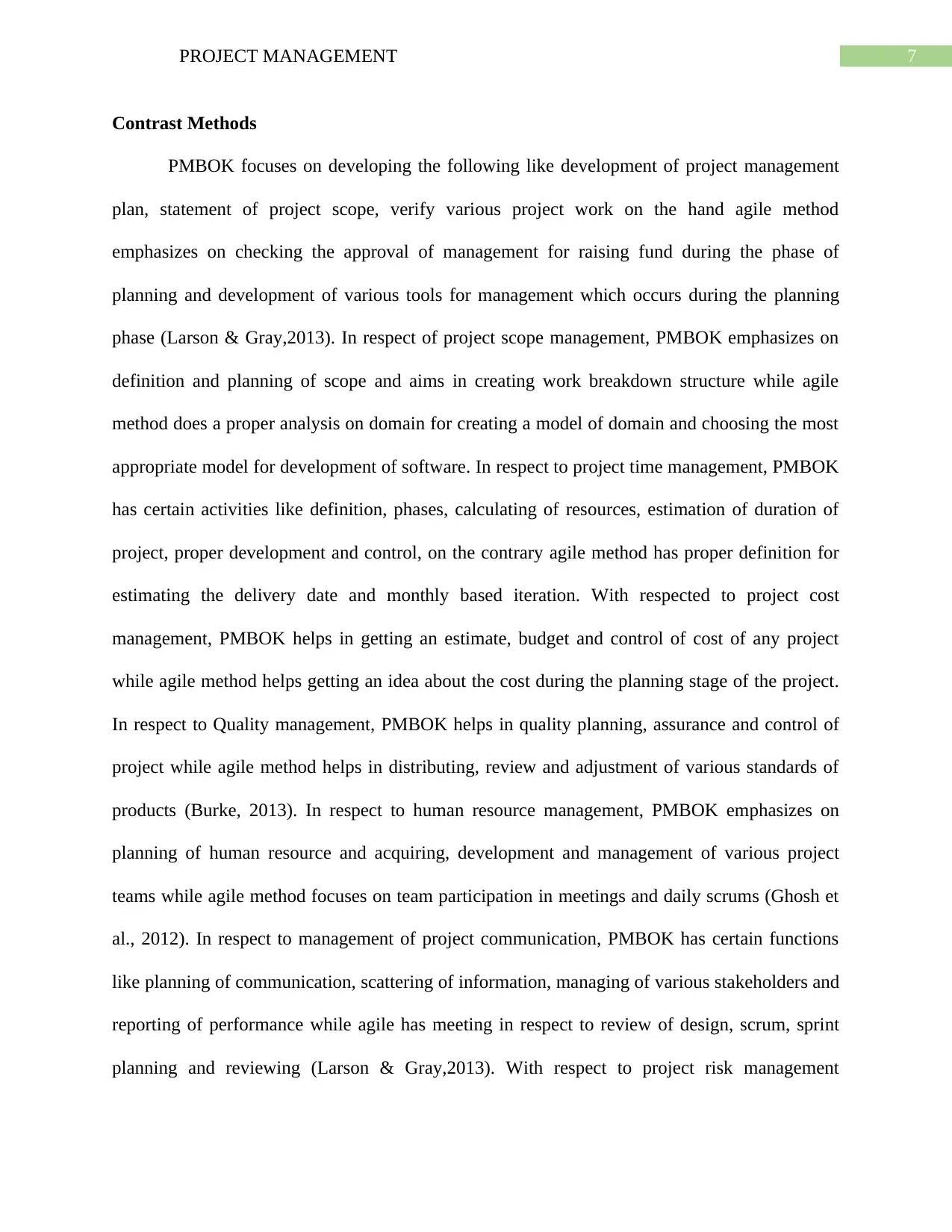
7PROJECT MANAGEMENT
Contrast Methods
PMBOK focuses on developing the following like development of project management
plan, statement of project scope, verify various project work on the hand agile method
emphasizes on checking the approval of management for raising fund during the phase of
planning and development of various tools for management which occurs during the planning
phase (Larson & Gray,2013). In respect of project scope management, PMBOK emphasizes on
definition and planning of scope and aims in creating work breakdown structure while agile
method does a proper analysis on domain for creating a model of domain and choosing the most
appropriate model for development of software. In respect to project time management, PMBOK
has certain activities like definition, phases, calculating of resources, estimation of duration of
project, proper development and control, on the contrary agile method has proper definition for
estimating the delivery date and monthly based iteration. With respected to project cost
management, PMBOK helps in getting an estimate, budget and control of cost of any project
while agile method helps getting an idea about the cost during the planning stage of the project.
In respect to Quality management, PMBOK helps in quality planning, assurance and control of
project while agile method helps in distributing, review and adjustment of various standards of
products (Burke, 2013). In respect to human resource management, PMBOK emphasizes on
planning of human resource and acquiring, development and management of various project
teams while agile method focuses on team participation in meetings and daily scrums (Ghosh et
al., 2012). In respect to management of project communication, PMBOK has certain functions
like planning of communication, scattering of information, managing of various stakeholders and
reporting of performance while agile has meeting in respect to review of design, scrum, sprint
planning and reviewing (Larson & Gray,2013). With respect to project risk management
Contrast Methods
PMBOK focuses on developing the following like development of project management
plan, statement of project scope, verify various project work on the hand agile method
emphasizes on checking the approval of management for raising fund during the phase of
planning and development of various tools for management which occurs during the planning
phase (Larson & Gray,2013). In respect of project scope management, PMBOK emphasizes on
definition and planning of scope and aims in creating work breakdown structure while agile
method does a proper analysis on domain for creating a model of domain and choosing the most
appropriate model for development of software. In respect to project time management, PMBOK
has certain activities like definition, phases, calculating of resources, estimation of duration of
project, proper development and control, on the contrary agile method has proper definition for
estimating the delivery date and monthly based iteration. With respected to project cost
management, PMBOK helps in getting an estimate, budget and control of cost of any project
while agile method helps getting an idea about the cost during the planning stage of the project.
In respect to Quality management, PMBOK helps in quality planning, assurance and control of
project while agile method helps in distributing, review and adjustment of various standards of
products (Burke, 2013). In respect to human resource management, PMBOK emphasizes on
planning of human resource and acquiring, development and management of various project
teams while agile method focuses on team participation in meetings and daily scrums (Ghosh et
al., 2012). In respect to management of project communication, PMBOK has certain functions
like planning of communication, scattering of information, managing of various stakeholders and
reporting of performance while agile has meeting in respect to review of design, scrum, sprint
planning and reviewing (Larson & Gray,2013). With respect to project risk management
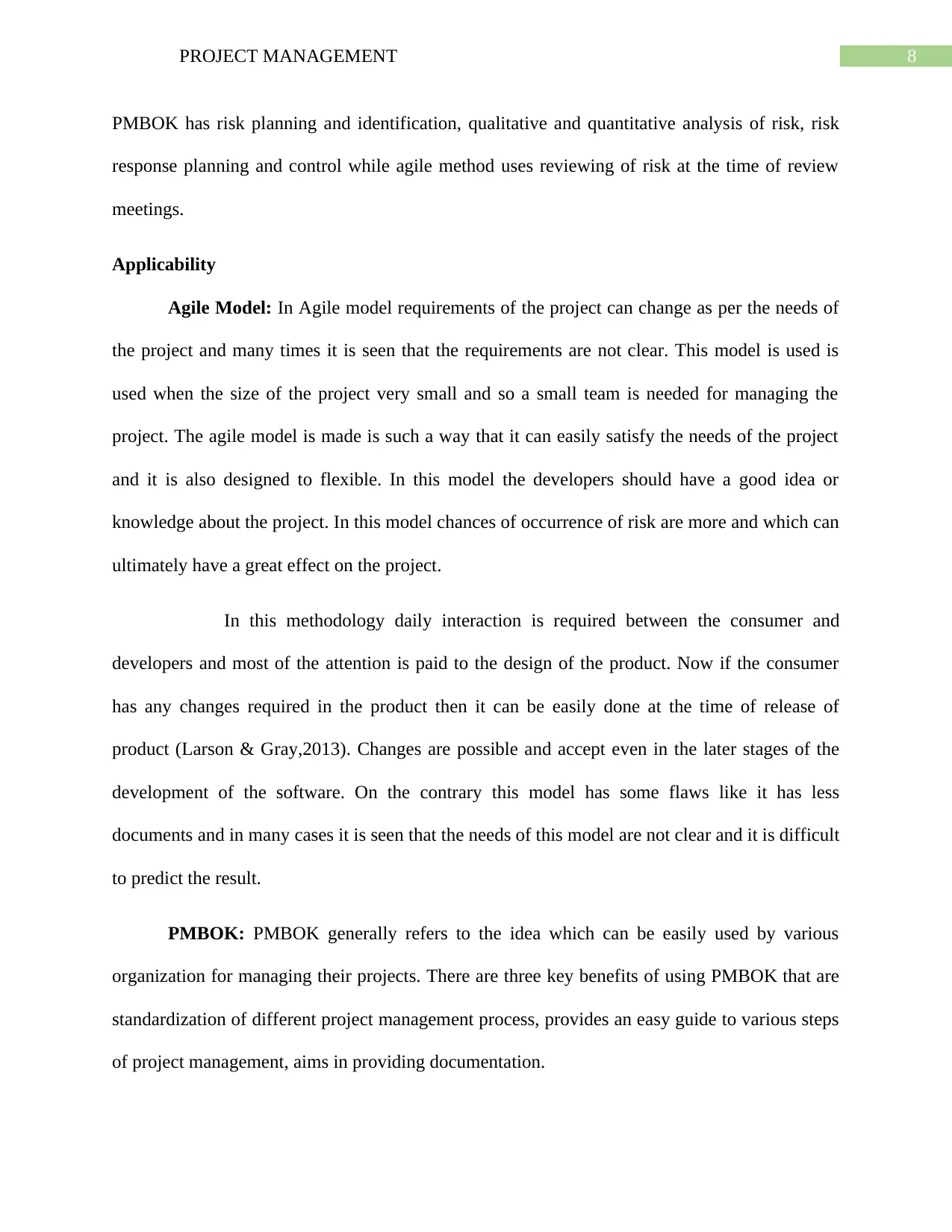
8PROJECT MANAGEMENT
PMBOK has risk planning and identification, qualitative and quantitative analysis of risk, risk
response planning and control while agile method uses reviewing of risk at the time of review
meetings.
Applicability
Agile Model: In Agile model requirements of the project can change as per the needs of
the project and many times it is seen that the requirements are not clear. This model is used is
used when the size of the project very small and so a small team is needed for managing the
project. The agile model is made is such a way that it can easily satisfy the needs of the project
and it is also designed to flexible. In this model the developers should have a good idea or
knowledge about the project. In this model chances of occurrence of risk are more and which can
ultimately have a great effect on the project.
In this methodology daily interaction is required between the consumer and
developers and most of the attention is paid to the design of the product. Now if the consumer
has any changes required in the product then it can be easily done at the time of release of
product (Larson & Gray,2013). Changes are possible and accept even in the later stages of the
development of the software. On the contrary this model has some flaws like it has less
documents and in many cases it is seen that the needs of this model are not clear and it is difficult
to predict the result.
PMBOK: PMBOK generally refers to the idea which can be easily used by various
organization for managing their projects. There are three key benefits of using PMBOK that are
standardization of different project management process, provides an easy guide to various steps
of project management, aims in providing documentation.
PMBOK has risk planning and identification, qualitative and quantitative analysis of risk, risk
response planning and control while agile method uses reviewing of risk at the time of review
meetings.
Applicability
Agile Model: In Agile model requirements of the project can change as per the needs of
the project and many times it is seen that the requirements are not clear. This model is used is
used when the size of the project very small and so a small team is needed for managing the
project. The agile model is made is such a way that it can easily satisfy the needs of the project
and it is also designed to flexible. In this model the developers should have a good idea or
knowledge about the project. In this model chances of occurrence of risk are more and which can
ultimately have a great effect on the project.
In this methodology daily interaction is required between the consumer and
developers and most of the attention is paid to the design of the product. Now if the consumer
has any changes required in the product then it can be easily done at the time of release of
product (Larson & Gray,2013). Changes are possible and accept even in the later stages of the
development of the software. On the contrary this model has some flaws like it has less
documents and in many cases it is seen that the needs of this model are not clear and it is difficult
to predict the result.
PMBOK: PMBOK generally refers to the idea which can be easily used by various
organization for managing their projects. There are three key benefits of using PMBOK that are
standardization of different project management process, provides an easy guide to various steps
of project management, aims in providing documentation.
⊘ This is a preview!⊘
Do you want full access?
Subscribe today to unlock all pages.

Trusted by 1+ million students worldwide
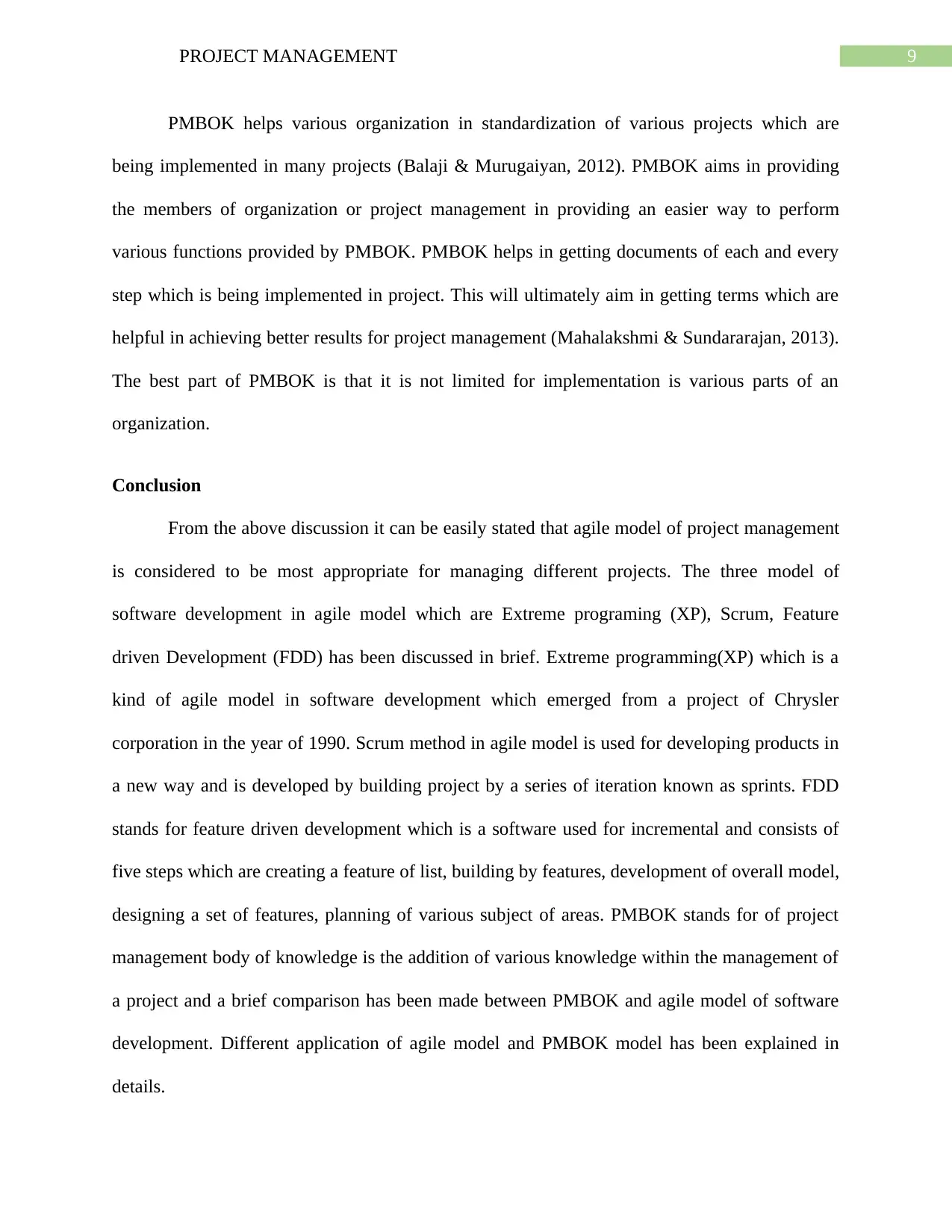
9PROJECT MANAGEMENT
PMBOK helps various organization in standardization of various projects which are
being implemented in many projects (Balaji & Murugaiyan, 2012). PMBOK aims in providing
the members of organization or project management in providing an easier way to perform
various functions provided by PMBOK. PMBOK helps in getting documents of each and every
step which is being implemented in project. This will ultimately aim in getting terms which are
helpful in achieving better results for project management (Mahalakshmi & Sundararajan, 2013).
The best part of PMBOK is that it is not limited for implementation is various parts of an
organization.
Conclusion
From the above discussion it can be easily stated that agile model of project management
is considered to be most appropriate for managing different projects. The three model of
software development in agile model which are Extreme programing (XP), Scrum, Feature
driven Development (FDD) has been discussed in brief. Extreme programming(XP) which is a
kind of agile model in software development which emerged from a project of Chrysler
corporation in the year of 1990. Scrum method in agile model is used for developing products in
a new way and is developed by building project by a series of iteration known as sprints. FDD
stands for feature driven development which is a software used for incremental and consists of
five steps which are creating a feature of list, building by features, development of overall model,
designing a set of features, planning of various subject of areas. PMBOK stands for of project
management body of knowledge is the addition of various knowledge within the management of
a project and a brief comparison has been made between PMBOK and agile model of software
development. Different application of agile model and PMBOK model has been explained in
details.
PMBOK helps various organization in standardization of various projects which are
being implemented in many projects (Balaji & Murugaiyan, 2012). PMBOK aims in providing
the members of organization or project management in providing an easier way to perform
various functions provided by PMBOK. PMBOK helps in getting documents of each and every
step which is being implemented in project. This will ultimately aim in getting terms which are
helpful in achieving better results for project management (Mahalakshmi & Sundararajan, 2013).
The best part of PMBOK is that it is not limited for implementation is various parts of an
organization.
Conclusion
From the above discussion it can be easily stated that agile model of project management
is considered to be most appropriate for managing different projects. The three model of
software development in agile model which are Extreme programing (XP), Scrum, Feature
driven Development (FDD) has been discussed in brief. Extreme programming(XP) which is a
kind of agile model in software development which emerged from a project of Chrysler
corporation in the year of 1990. Scrum method in agile model is used for developing products in
a new way and is developed by building project by a series of iteration known as sprints. FDD
stands for feature driven development which is a software used for incremental and consists of
five steps which are creating a feature of list, building by features, development of overall model,
designing a set of features, planning of various subject of areas. PMBOK stands for of project
management body of knowledge is the addition of various knowledge within the management of
a project and a brief comparison has been made between PMBOK and agile model of software
development. Different application of agile model and PMBOK model has been explained in
details.
Paraphrase This Document
Need a fresh take? Get an instant paraphrase of this document with our AI Paraphraser

10PROJECT MANAGEMENT
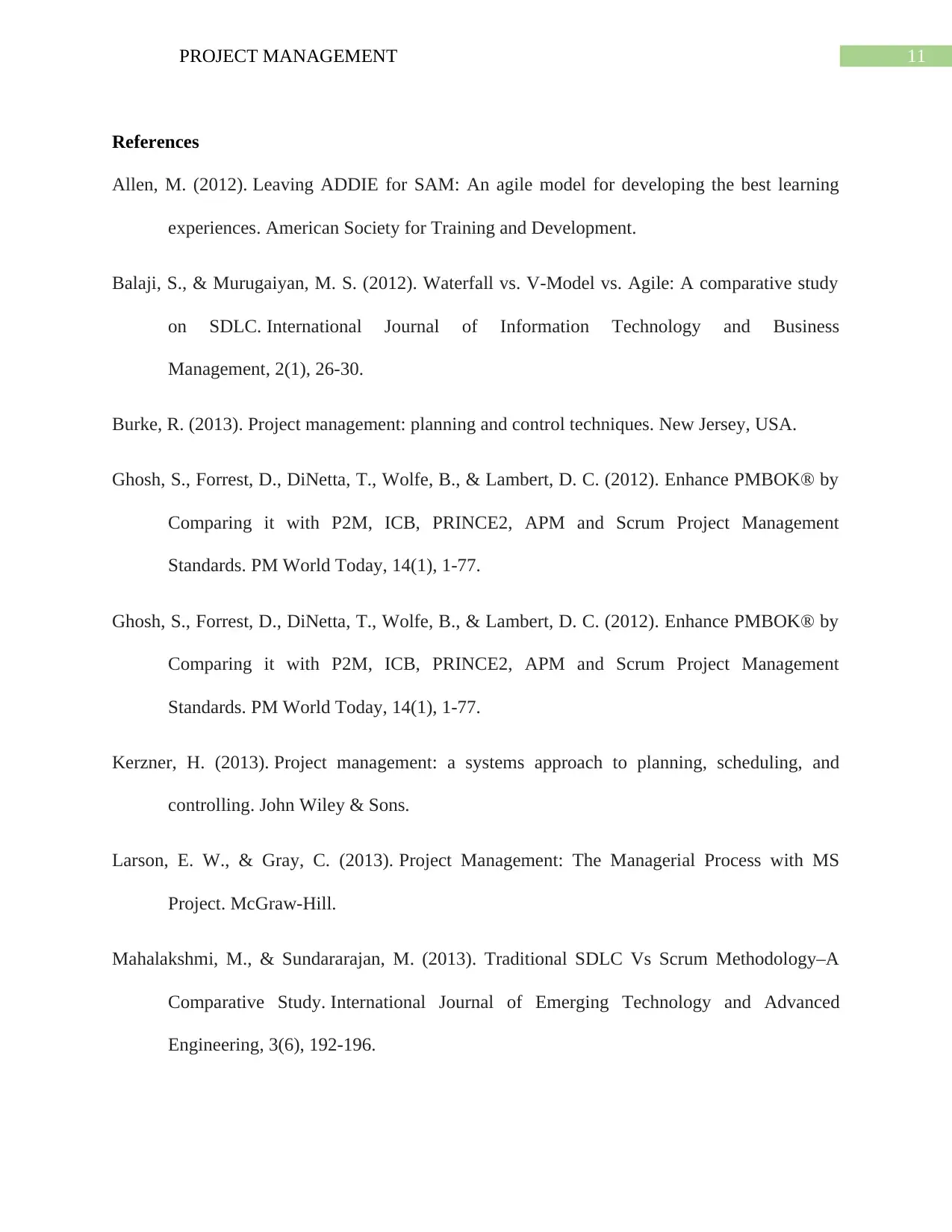
11PROJECT MANAGEMENT
References
Allen, M. (2012). Leaving ADDIE for SAM: An agile model for developing the best learning
experiences. American Society for Training and Development.
Balaji, S., & Murugaiyan, M. S. (2012). Waterfall vs. V-Model vs. Agile: A comparative study
on SDLC. International Journal of Information Technology and Business
Management, 2(1), 26-30.
Burke, R. (2013). Project management: planning and control techniques. New Jersey, USA.
Ghosh, S., Forrest, D., DiNetta, T., Wolfe, B., & Lambert, D. C. (2012). Enhance PMBOK® by
Comparing it with P2M, ICB, PRINCE2, APM and Scrum Project Management
Standards. PM World Today, 14(1), 1-77.
Ghosh, S., Forrest, D., DiNetta, T., Wolfe, B., & Lambert, D. C. (2012). Enhance PMBOK® by
Comparing it with P2M, ICB, PRINCE2, APM and Scrum Project Management
Standards. PM World Today, 14(1), 1-77.
Kerzner, H. (2013). Project management: a systems approach to planning, scheduling, and
controlling. John Wiley & Sons.
Larson, E. W., & Gray, C. (2013). Project Management: The Managerial Process with MS
Project. McGraw-Hill.
Mahalakshmi, M., & Sundararajan, M. (2013). Traditional SDLC Vs Scrum Methodology–A
Comparative Study. International Journal of Emerging Technology and Advanced
Engineering, 3(6), 192-196.
References
Allen, M. (2012). Leaving ADDIE for SAM: An agile model for developing the best learning
experiences. American Society for Training and Development.
Balaji, S., & Murugaiyan, M. S. (2012). Waterfall vs. V-Model vs. Agile: A comparative study
on SDLC. International Journal of Information Technology and Business
Management, 2(1), 26-30.
Burke, R. (2013). Project management: planning and control techniques. New Jersey, USA.
Ghosh, S., Forrest, D., DiNetta, T., Wolfe, B., & Lambert, D. C. (2012). Enhance PMBOK® by
Comparing it with P2M, ICB, PRINCE2, APM and Scrum Project Management
Standards. PM World Today, 14(1), 1-77.
Ghosh, S., Forrest, D., DiNetta, T., Wolfe, B., & Lambert, D. C. (2012). Enhance PMBOK® by
Comparing it with P2M, ICB, PRINCE2, APM and Scrum Project Management
Standards. PM World Today, 14(1), 1-77.
Kerzner, H. (2013). Project management: a systems approach to planning, scheduling, and
controlling. John Wiley & Sons.
Larson, E. W., & Gray, C. (2013). Project Management: The Managerial Process with MS
Project. McGraw-Hill.
Mahalakshmi, M., & Sundararajan, M. (2013). Traditional SDLC Vs Scrum Methodology–A
Comparative Study. International Journal of Emerging Technology and Advanced
Engineering, 3(6), 192-196.
⊘ This is a preview!⊘
Do you want full access?
Subscribe today to unlock all pages.

Trusted by 1+ million students worldwide
1 out of 14
Related Documents
Your All-in-One AI-Powered Toolkit for Academic Success.
+13062052269
info@desklib.com
Available 24*7 on WhatsApp / Email
![[object Object]](/_next/static/media/star-bottom.7253800d.svg)
Unlock your academic potential
Copyright © 2020–2025 A2Z Services. All Rights Reserved. Developed and managed by ZUCOL.





